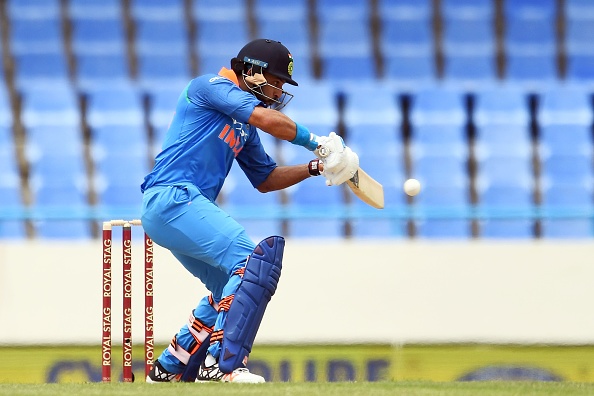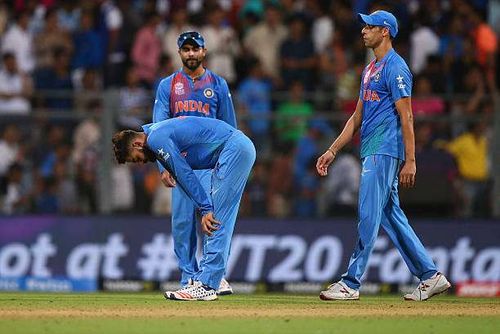
What plagues the Indian Twenty20 Team?
India’s loss against the West Indies last night was a disturbing reminder of the World T20 semi-final for Indian fans. Once is a fluke, twice is a trend and India’s team composition is to blame. India are 7 years behind the rest of the world in T20 Internationals, a giant problem hiding behind Virat Kohli.
It is because of the old ways of thinking that India, despite having the biggest and most star-studded T20 league, the most resources and the biggest player pool, have still performed well below par in 20 over cricket.
Understanding India’s losses in the last few years
In the last two years, India have lost games in the following ways:
Scored under-par on a flat wicket, one batsman in the opposing team makes a big score and chases it down comfortably
Examples: West Indies, in the T20 World Cup 2016; West Indies, the one off T20I 2017; England vs India, 1st T20I 2017 and India vs South Africa, 1st T20 2015.
This often indicates a lack of fast starting hitters. Often, on flat wickets, ODI batsmen get set and then try to accelerate. This wastes balls. Bowling spinners that don’t turn it much or both ways is usually a liability on these wickets, and they go at north of 10 runs per over, unless they’re used to open the bowling.
Kohli gets out early in the chase and India mess up a chase
Examples: New Zealand T20 World Cup 2016; India vs West Indies 1st T20 2016; India vs Zimbabwe 2nd T20 2015.
What happens here is there is nobody to marshal the chase. Hitters are good at scoring quick runs but they do not take India over the line. This happens when the pitch is a little tough, and hitters score a boundary or two, but a proper batsman is needed after Kohli to bat alongside the hitters, to take India home.
India’s batsmen all suddenly collapse on a seaming, bouncy pitch.
Examples: India vs South Africa 2nd T20 2015; India vs Sri Lanka 1st T20 2015.
The white ball does not swing outside the first few overs. However, India’s players are known to struggle on seaming wickets, with not many of India’s ODI players able to play when the ball is doing a bit. By protecting them by sending a technically correct batsman opening, as well as having one technical player in the middle order.
On average, India lose just above 5 wickets per game in T20Is, the least by some margin of the 9 top nations. While conventionally this is a good thing, it indicates that Indian batsmen put a high price on their wicket. They also score on average, 162 runs per 20 overs, not even near the top teams. This furthers the idea India are not utilising their 120 balls and 10 wickets. Essentially, their model is out of date.
Extra cover: Cricket and the attraction of the imperfect dashers
The days where 180 is a safe score on any wicket are gone, and T20 bowlers have become better, offering fewer bad balls and with data analysis on the rise, they know every batsman’s weakness. This means that triggering an Indian collapse is not difficult. India are a time bomb waiting to explode in T20s, major issues are blanketed by Virat Kohli’s class and Jasprit Bumrah’s death bowling perfection. While there is no T20I tournament for the next 3 years, they will need to up their game in bilateral series if they are to push towards the #1 ranking.
So what needs to be done?

In an article for ESPN Cricinfo, Jarrod Kimber outlined what a winning team composition would look like in T20 cricket. His XI looks something like this:
Openers
Opener who starts hitting from ball one (eg. England’s Jason Roy)
Accumulator who rotates strike, hits bad balls and doesn’t get out early (eg. Joe Root)
Middle Order (the order has to be flexible to the scenario)
Batsman that stops a collapse, who will rotate strike and rebuild. (eg. Kane Williamson)
Slow starting big hitter (eg. Brad Hodge)
Fast starting hitter 1: better at playing spin (eg. Hardik Pandya)
Fast starting hitter 2: better at hitting pace (eg. Corey Anderson)
Fast starting hitter 3: hits both pace and spin (eg. AB de VIlliers)
Lower Order
Spin Bowler who turns it both ways (eg. Shadab Khan)
An Express pace bowler (eg. Pat Cummins)
A Genuine Swing bowler (eg. Mohammad Amir)
A Death bowling specialist (eg. Dwayne Bravo)
The way this would all click together is that the team fields 7 batsmen, of which one is a proper keeper and one is a part-time spinner. The batting order changes around depending on the situation. On a flat wicket, the opening hitter might click and get the team off to a flier, and then will need the fast-scoring hitters to come in and give it a swing.
On a tougher wicket, where the opener gets out, the proper batsman in the middle order would rebuild with the proper opener, before handing it off to the slow starting hitter and eventually the fast starting hitters to put on a good score.
A part time spinner would open the bowling, someone like a Tom Cooper in the BBL, bowling 3 accurate overs in the powerplay, keeping the scoring low in the powerplay, as well as using up 3 overs of the 5th bowler. The death bowling specialist and the swing bowler would bowl at the death, the swing bowler would also open the bowling along with the spinner. The express pace bowler and the spinner who turns it both ways would dominate the middle overs, taking regular wickets.
How does India’s team compare against this model?

Let us have a look at India’s team for the World T20 series earlier last year, which has been their first-choice team for the last year or so.
Shikhar Dhawan (Too slow to play the opening hitter role)
Rohit Sharma (Too inconsistent to play the accumulator role)
Virat Kohli (good for the proper batsman role)
MS Dhoni (slow starting hitter and wicketkeeper)
Suresh Raina (too slow starting to be a fast-starting hitter)
Yuvraj Singh (too slow to be a fast-starting hitter)
Hardik Pandya (perfect for the fast hitter of spin role)
Ravindra Jadeja (can be replaced with an express pace bowler)
Ravichandran Ashwin (turns it both ways, but has declined in the last few years)
Jasprit Bumrah (perfect death bowler)
Bhuvneshwar Kumar (perfect swing bowler)
The batting is a mess, and it shows. Shikhar Dhawan and Rohit Sharma, if they click, can score at a decent clip, but not fast enough. Virat Kohli acts like an accumulator, but if he fails, the team often collapses. The batsmen at the back end can’t score quickly enough, and take too long to start. More often than not, India plays 2 regular spinners in Ashwin and Jadeja.
Extra cover: 5 things India did wrong to lose the one-off T20I
Ashwin turns it both ways but he has been missing his lines and lengths of late. Furthermore, as lower order batsmen, both Ashwin and Jadeja, score at 6.60 and 7.37 runs per over respectively, far below what is needed from numbers 8 and 9. A wristspinner and a batting allrounder would be good replacements. The pace bowlers need to be complemented by someone bowling 142 kph+ consistently in the middle order in tandem with the wristspinner, to eke out wickets.
What XI should India play?

This is what my ideal Indian T20 lineup is:
Rishabh Pant (to take the attack to the bowlers early)
Virat Kohli (Virat is Virat)
Rohit Sharma (versatile slow starting hitter)
KL Rahul (proper batsman to stop a collapse)
Kedar Jadhav (fast starting hitter - fast bowling, can bowl in the powerplay)
Krunal Pandya (fast-starting hitter, will open the bowling)
Hardik Pandya (fast starting hitter- spin bowling, can bowl at the death if needed)
Kuldeep Yadav/Amit Mishra (spinner to turn it both ways)
Umesh Yadav (express pace)
Bhuvneshwar Kumar (swing bowler/ death bowler)
Jasprit Bumrah (death bowling specialist)
This type of lineup, with a versatile batting order, allows batsmen like Virat Kohli and KL Rahul to stop a collapse, with hitters like Kedar Jadhav, Hardik Pandya and Rishabh Pant, who score at 8.26, 8 and 9 RPO respectively, to each be able to score those crucial 30 off 12 balls when the openers set it up nicely. If India lose a couple of wickets, Rohit, KL Rahul and Virat, could rebuild, before Rohit finally takes the attack to the bowlers.
The value for wickets is much less in T20I, and getting set is overrated. Every batsman must play an explosive brand of cricket, except the two proper batsmen, who will also be rotating strike, because there are batsmen left who can score quickly. Currently, their wickets are not worth the balls they are spending on getting set. The bowlers speak for themselves and their roles are pretty clearly defined.

This team is also full of gun fielders and even has two spare wicketkeepers. Kedar Jadhav and Jasprit Bumrah are the only two players who could let the team down on the field.
India have made a T20 team using an ODI template. Unless they follow the template the West Indies used to win the World T20, they will continue to be dinosaurs in this format. Indian batsman may be superstars in India, but overvaluing of their wickets makes them liabilities in the shortest format. The Mumbai Indians tried a similar sort of team in the IPL 2017 a template which worked excellently.
In India, getting ridding of a wasteful old guard is difficult. It is also difficult to reel in “western” ideas. The Indian team has always been slow to react to changes in the cricket environment. It is the same reason that Indian cricket clung onto its old stars in ODIs for so long, did not accept the DRS until last year, hasn’t played a day-night Test and still has N Srinivasan lurking in the shadows.
Because of its superstar, Virat Kohli, who really can do nothing wrong, the glaring mistakes are just a little more palatable. But it is time to wake up and smell the rot, because it’s a problem that’s not getting solved by changing personnel. It’s an issue that needs a rethinking of the T20 approach. Indian T20 cricket is followed by millions of fans, who all wish India can some day replicate their 2007 success.
It’s just a shame that India are trying to win with those same, old techniques.
